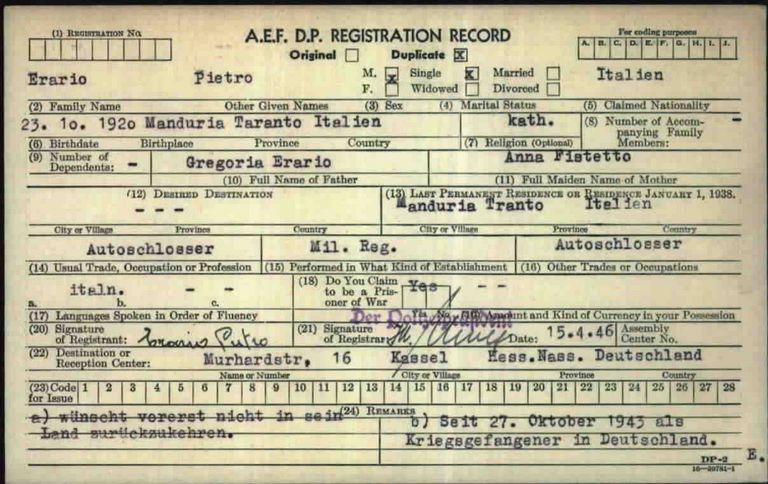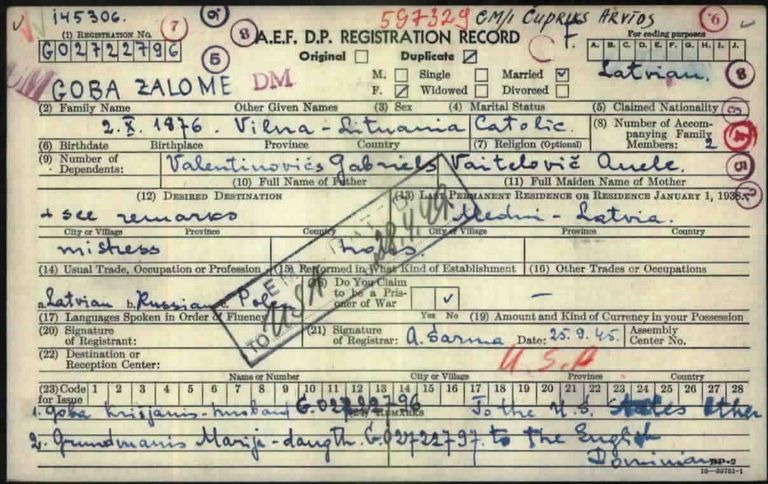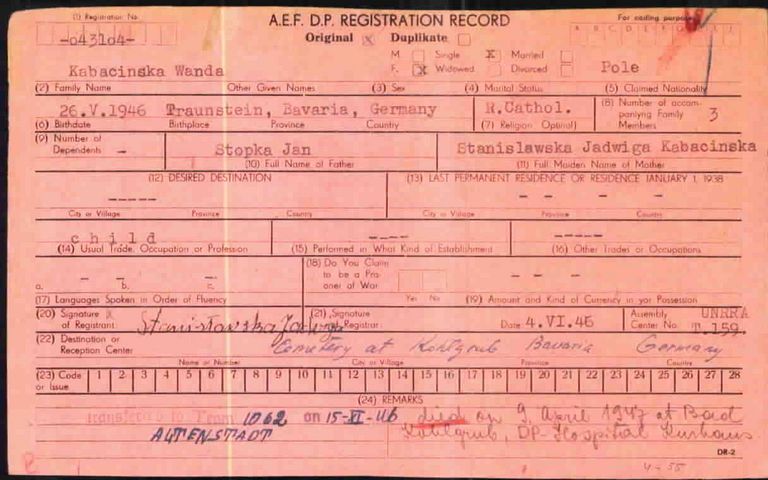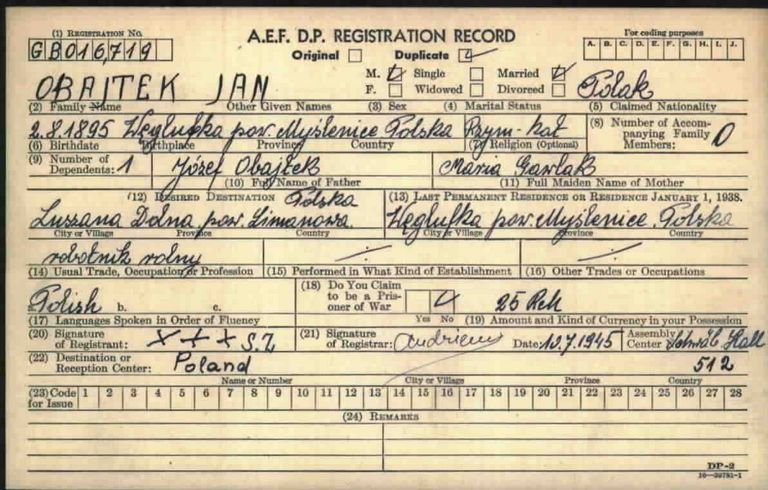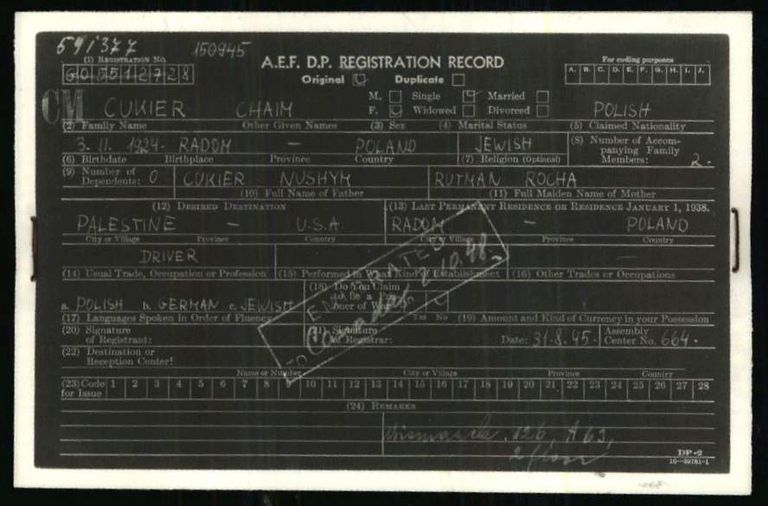Page of
Page/
- Reference
- Intro
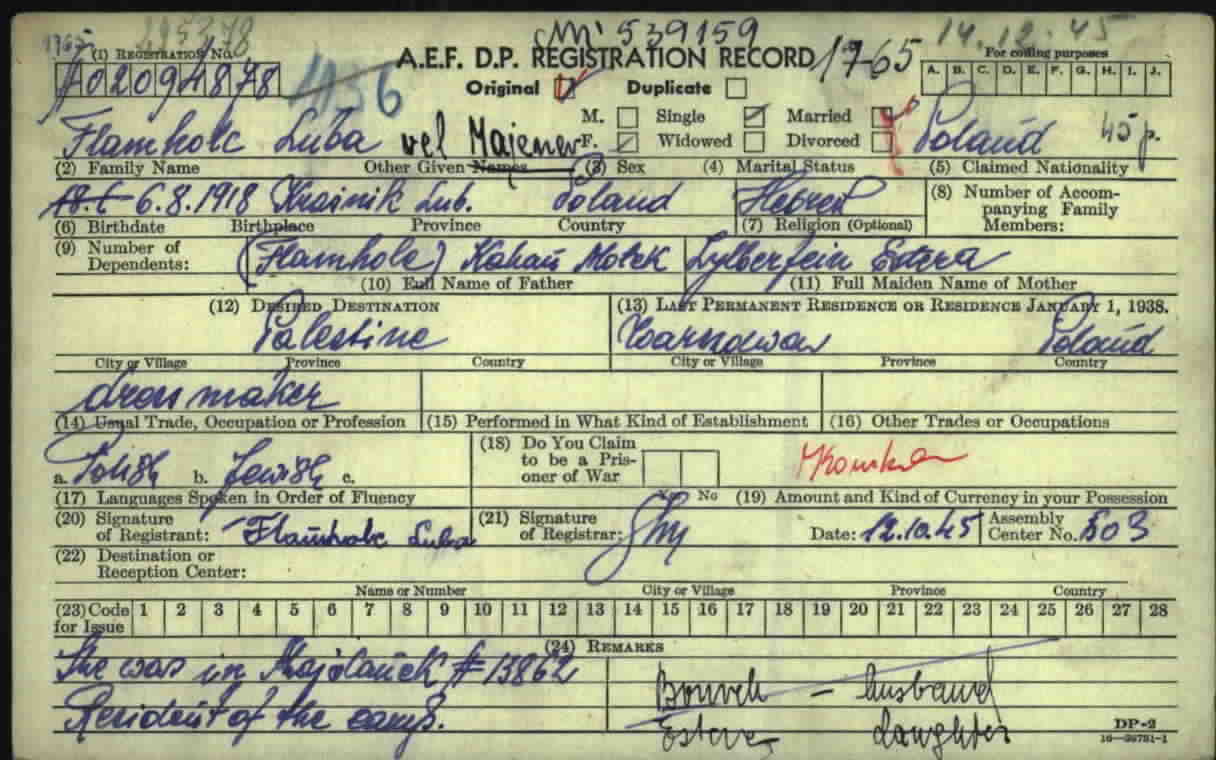

In November 1944, the Allies stipulated that DPs had to be registered. In the British and US occupation zones, they used two DP 2 cards per person to do this. After registration, the DPs took the original card with them when they moved to a different camp or returned to their country of origin. The duplicate card was sent to the ITS and other tracing services. Since multiple people added information to the cards during this process, many cards are strewn with stamps, abbreviations and handwritten notes.
In November 1944, the Allies stipulated that DPs had to be registered. In the British and US occupation zones, they used two DP 2 cards per person to do this. After registration, the DPs took the original card with them when they moved to a different camp or returned to their country of origin. The duplicate card was sent to the ITS and other tracing services. Since multiple people added information to the cards during this process, many cards are strewn with stamps, abbreviations and handwritten notes.
Questions and answers
-
Where was the document used and who created it?
The Allies had clearly delineated tasks when dealing with liberated forced laborers and concentration camp prisoners: they had to register them, distribute food and clothing, provide medical aid and clarify their fate. To organize all of this, the Allies developed a system in 1944 involving three cards: the DP 1, DP 2 and DP 3 card. These cards were used to record information about all DPs when they were first registered by a British or US authority. Registration could be carried out in a camp in the British or US zone in western Germany, or in one of the territories previously occupied by the Nazis, i.e., France, Denmark, Belgium, Luxembourg or the Netherlands. The card with the most information was the DP 2 card, officially known as the registration record.
On their advance through Western Europe and in the first weeks after the liberation, military authorities recorded the DPs’ responses to questions on the DP 2 cards and supplementary records, if necessary. From the fall of 1945, UNRRA employees gradually began taking over the administration of the DP camps and acting as “center registrars” who registered the DPs using the DP 2 cards. In many cases, they received support from DPs who worked for them, conducting interviews and writing the answers on the cards. On the back of the DP 2 cards there were special fields to be filled out by the medical supervisors in the DP camp.
Registration took place either in a DP camp itself or in a District Control Center. Admission Control was a special area in the DP camps that had been set up for new arrivals. It was separated from the rest of the camp because the people in it first had to be disinfected to prevent the spread of diseases. The registration procedure changed over time with the introduction of the District Control Centers. From this point on, all persons requesting aid were supposed to go through a District Control Center, which would check whether they met the requirements for DP status. If so, they would be assigned to a DP camp. Employees of the District Control Center would then either fill out the DP 2 card on site or issue a referral slip that the DPs had to give to the center registrar, who would then fill out the card in the camp itself. DP 2 cards were not initially filled out for so-called free-living DPs who chose to live not in camps but in private accommodations. Instead, German administrators would record these DPs on lists for the respective towns.
Two DP 2 cards were always issued for each person: one original and one duplicate. Depending on where the DP 2 cards wound up, they would be used by different offices. One card was kept by the DP and used by UNRRA employees in all of the DP’s subsequent camps. From 1947, the number of newly issued DP 2 cards declined, and the employees of UNRRA’s successor organization – the IRO – would usually only add to the cards that already existed. For this reason, DP 2 cards can bear the handwriting of many people from the various places the DPs resided before returning home or emigrating. The second DP 2 card was filled out as a duplicate for the Central Tracing Bureau (CTB) and its zonal tracing offices. Tracing inquiries from all over the world were sent to the CTB in Arolsen in northern Hessen, which developed into the International Tracing Service (ITS) in 1948. The employees here used the DP 2 cards to determine who had survived the war and where they were currently located.
- When was the document used?
The DP 2 cards can be traced back to an instruction from November 1944. A letter stored in the Arolsen Archives verifies that US military units were already filling out DP 2 cards just a month later, in December 1944. UNRRA and IRO employees continued using DP 2 cards in the following years, as can be seen in the additional updates made to the cards. Fewer and fewer new cards were issued from 1947 onwards because most DPs had already received a DP 2 card by this time.
After the IRO was disbanded in December 1951, the majority of the DP 2 cards that were not given directly to Arolsen went first to the office of the UN High Commissioner for Refugees in Bad Godesberg. From there, the cards – together with a total of 32 tons of DP documents, including DP 3 cards and CM/1 files – were sent to the ITS. The ITS was already storing DP 2 cards that had been created for tracing purposes. Today all of these cards are held together in the postwar card file (Nachkriegszeitkartei, Collection 3.1.1.1) of the Arolsen Archives.
- What was the document used for?
DP 2 cards served different purposes depending on whether they were carried by the DPs themselves or sent to other offices for tracing activities. The cards the DPs brought with them to the DP camps were used primarily for organizational purposes, since the camps were places of constant change. UNRRA employee Katie Louchheim recalls that, in a Mannheim DP camp set up for 6,000 DPs, a total of 716 people arrived and 1,197 left the camp in a single day shortly after the end of the war. DPs were always on the move right after the war; they were transferred to other camps, treated in hospitals, or sent back to their countries of origin (i.e., repatriated). In this situation, the DP 2 cards helped keep track of who was currently in a camp. Camp administrative employees sorted the DP 2 cards into what were known as assembly center files. These card files, which held all of the DP 2 cards for the DPs present in a camp, was ordered first by nationality and then by registration number. This was important when it came to providing aid on site. Additionally, based on the DP 2 cards, the camp employees would compile an Assembly Center Weekly Report (form CA/d4 Revised) to keep the Supreme Headquarters, Allied Expeditionary Force (SHAEF) updated on the situation. The reports had to be sent weekly and were organized according to the nationalities stated by the DPs. The central authorities thus always knew how many DPs of a particular nationality there were in a camp, so they could arrange for their repatriation in groups. When DPs were returned to their countries of origin, camp employees would gather the DP 2 cards for the whole transport and hand them to a group or transport leader, who took the cards to the respective countries.
The second DP 2 card was used by various organizations to provide information for tracing inquiries. To begin with, the cards were sent to the military government, or more precisely, to the G-5 Division/Displaced Persons Branch of SHAEF. Three card files were created here: one for deceased individuals, one for DPs who could not be repatriated, and one for all the rest. By the autumn of 1945 at the latest, the first cards were sent from there to UNRRA, who was responsible for caring for the DPs. UNRRA employees tried to complete the information on the cards. It was especially important for them to know whether a person had returned to their country of origin or not.
A few years later, after the remaining DP 2 cards had been given to the ITS following the dissolution of the IRO (the successor to UNRRA), the DP 2 cards found yet another purpose. ITS employees not only consulted the cards to help relatives with tracing inquiries, they also used them when a DP needed to be officially recognized as a “homeless foreigner.” When the IRO stopped providing support to the DPs at the end of 1951, the around 130,000 DPs still living in Germany were given the status of “homeless foreigners” (“Heimatlose Ausländer”), and they became the responsibility of the Federal Republic of Germany. To ensure that this status was only given to people entitled to it, German administrators had the ITS check whether an individual had previously received support from UNRRA or the IRO. The DP 2 cards were also used later on for handling compensation claims. The authorities at the time placed great trust in the accuracy of the information on the cards.
- How common is the document?
Unfortunately, it is impossible to say exactly how many DP 2 cards are now stored in the Arolsen Archives. The cards were not kept in their own card file, but are instead part of the postwar card file (Nachkriegszeitkartei, Collection 3.1.1.1) created by the ITS in the 1950s. What is certain, however, is that DP 2 cards are the most numerous documents in the postwar card file. According to a list from 1951, the ITS already had 1.6 million DP 2 cards at the time. Between April 1951 and May 1953, close to another 600,000 DP 2 cards arrived in Arolsen.
In later years, more copies of DP 2 cards found their way to Arolsen, but they were not placed in the postwar card file. DP 2 cards for forced laborers from municipal archives were placed by ITS employees in the wartime card file. Collection 7.7.1 also holds copies of nearly 7,000 DP 2 cards from the archive of the Service of War Victims in Belgium. The owners of the cards were either registered in Belgium or were Belgians. Copies of another 7,000 or so DP cards were sent to the ITS from the Danish National Archives in Copenhagen in 1993. They came from people who were in Denmark at the end of the war. Original DP 2 cards can also still be found among the CM/1 files for other people.
Despite these additions to the archive, the Arolsen Archives do not have a card for every single DP. Therefore, what was written in the “Third Progress Report” of the ITS for West German compensation authorities back in 1952 still applies today: “Fundamentally, however, we must stress that we are not in possession of all DP 2 cards, so a negative response on our part does not mean the applicant was not registered as a DP” (6.1.1/82508356/ITS Digital Archive, Arolsen Archives, translation of the German original).
- What should be considered when working with the document?
Theoretically, there should always have been precisely two DP 2 cards for each DP. In reality, however, this was not always the case. This means there can be multiple DP 2 cards for a single person in the Arolsen Archives. The employees of the Central Records Office found a solution to this problem back in July 1945: they simply stapled the cards together. Additionally, reports from this period (such as from November 1945) complain that the center registrars in the camps were not filling out the cards precisely according to instructions. Therefore, it is important to bear in mind that most of the cards were filled out in a hectic and confused postwar situation.
The information on the DP 2 cards – which were supposed to be filled out in ink or on a typewriter – is based on the statements of the DPs themselves. It therefore comprises the details that they could remember, that they wanted to share or that they did not deliberately hide. For any number of reasons, there may be discrepancies when the DP 2 cards are compared with other documents for the same person. For example, the nationality of Eastern and Central European DPs determined whether they would be repatriated against their will to countries that were in the Soviet Union’s sphere of power after the war. On account of this, as well as the fear of not receiving support, DPs sometimes left out certain aspects of their background.
Nonetheless, the cards are important historical documents because, among other things, they tell us something about the DPs’ life after the war. For example, emigration data is often noted on the cards. In these cases, it is important to remember that a DP’s actual departure date may differ from the date mentioned on the DP 2 card. An ITS progress report from 1953 addressed this issue: “It has become apparent that the entries about emigration in the official emigration lists of the IRO and the Jewish Agency for Palestine can differ from the entries about emigration on the DP 2 cards, sometimes insignificantly but sometimes considerably. An earlier date on the DP 2 card can generally be considered the date of departure to the transient camp. In a larger number of cases, a later emigration date is given on the DP 2 card than on the departure list. This is to be considered the administrative date on which the decrease in the camp’s population was recorded and, according to the statements of former Control Center employees, it was only entered later due to the work overload and shortage of personnel” (Fifth Progress Report of the International Tracing Service, May 22, 1953, Folder No. 4595/ITS Archive, Arolsen Archives, pp. 203-215, here pp. 205f., translation of the German original). For this reason, it is always worth looking at the ship lists stored in the Arolsen Archives, which provide more accurate dates and are proof of a DP’s departure. These lists can be viewed in the online archive.
If you have any additional information about these cards, we would appreciate it very much if you could send your feedback to eguide@arolsen-archives.org. New findings can always be incorporated into the e-Guide and shared with everyone.
Help for documents
About the scan of this document <br> Markings on scan <br> Questions and answers about the document <br> More sample cards <br> Variants of the document
